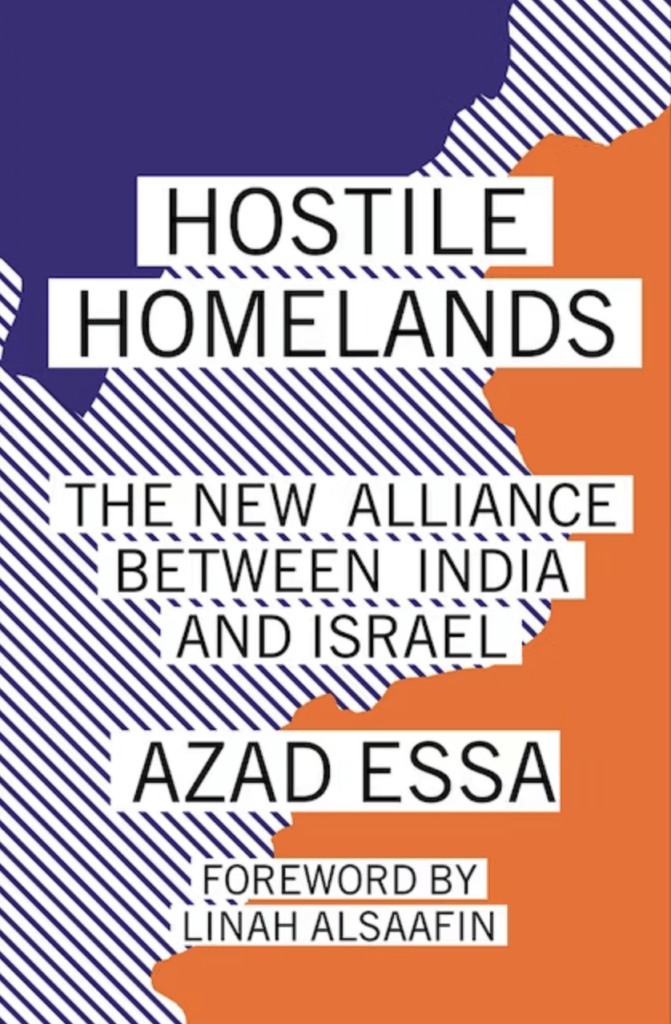HOSTILE HOMELANDS
The New Alliance Between India and Israel
by Azad Essa
240 pp. Pluto Press, $22.95
Azad Essa’s Hostile Homelands is one of the most comprehensive accounts that have come up in recent years about the “new” alliance between India and Israel. The “new” alliance, as Essa proves, is actually quite old. Thus, the book is set up as an exploration of both the historical background and ideological underpinnings of this ever-blossoming relationship.
Essa argues that the state of Israel has increasingly become the cornerstone of India’s foreign policy, with India’s treatment of Kashmir bearing close resemblance to Israel’s settler-colonial project. Essa is a South African journalist who has covered both Palestine and Kashmir extensively, the two subjects of his book, and the book serves as a tremendous act of solidarity with people in these two hostile homelands.
Essa begins by tracing out the first few contacts that were made between the Indian National Movement and Zionist Movement. It starts with Jawaharlal Nehru’s 1936 address (he was then a leader in the movement) in which he vehemently denounced the settler-colonial tendencies of the Zionist movement. However, it would be Nehru himself, as the first Prime Minister of an independent India, who would establish backchannel communications with Israel and even try to include it in the 1955 Bandung Conference.
The answers to these contradictions lay in the Hindu nationalist ideology called Hindutva, which despite the secular posturing of the Indian National Movement (and later the Republic of India), has always dominated the Indian polity.
Many leaders of India’s anti-colonial struggle were unmistakably Islamophobic and admired the Zionist movement for the same. The deep-rooted Islamophobia of India’s national movement precipitated insecurities in its largest religious minority, Muslims. This, in turn, resulted in one of the most brutal episodes of population transfers of modern history, the Partition of British India into the Republics of India and Pakistan. Even after seventy-five years of Independence and Partition, India has done little to both acknowledge that shameful aspect of its history or address it. For a greater part of its history, India has been able to maintain the image of a secular and modern democracy. It is only with the rise of the current regime that its Islamophobia became evident to the people outside the subcontinent. But “Hindutva” is not just about Islamophobia, it is more importantly about casteism.
Casteism, Hindutva, and Zionism
Casteism is a social system wherein people are divided from birth into a system of hierarchy. This system is so unique to the Indian subcontinent that there are few parallels in the world, and it dominates every aspect of the Indian polity.
The caste system has been in place for at least two thousand years, and according to it, society is divided into four strata: Brahmins (priestly class), Kshatriya (warriors), Vaishyas (merchants, artisans, tradesmen, and farmers), and Shudras (laboring class). These four categories have unique local adaptations in the vast Indian sub-continent, and each of these adaptations is known as jati. People born outside this system are called outcastes or, as they have named themselves, “Dalits.” This also includes India’s tribal population, a significant number in themselves. For most of India’s history in the last two thousand years, Shudras, Dalits, and tribal populations have remained under brutal domination of the upper castes with very few examples of successful political challenges to it.
There is, however, a long tradition in India of challenging the spiritual dominance of the upper castes (i.e., Brahmins). Nevertheless, the material reality for the lower castes and outcastes continues to be deplorable. It is important to mention that casteism in India is not confined to just Hindus. Adherents of other faiths, like Christianity and Islam, also practice casteism. But it is in the Hindu scriptures that casteism gets its theological basis and teeth for continuous dominance.
It was only under British rule that a significant material challenge was posited against the upper caste dominance, mainly through the new avenues of social mobility that opened with the modern education system. The response to this challenge to casteism was the Rashtriya Swayamsevak Sangh (RSS), the parent body of the current ruling party in India, the Bharatiya Janata Party (BJP). The RSS is not an electoral force in the sense that it does not contest elections under its name. However, its political offshoots like the BJP do so in its place. The RSS is the most highly organized, resourceful, and influential organization in India. Its members occupy significant positions in all three branches of the Indian state: judiciary, executive, and legislature.
Zionism, like India’s casteism, is a supremacist ideology that entitles certain people to exclusive rights based on religion. Zionism seeks to establish an ethnic Jewish state, or Eretz Israel, in historical Palestine, emptied of all other ethnicities or faith. Hindutva, similarly, wishes to establish a Hindu Rasthra or Hindu nation in the Indian subcontinent where the social order of casteism is practiced without the challenges brought about by the modern education system and polity. The two ideologies share much in common and, therefore, became natural allies.
Essa is especially impressive when he studies this cross-breeding between “Hindutva” and Zionism in an overlooked arena of the Indian polity, the Indian diaspora in the U.S. He carefully lays out the caste composition of this group, and moreover, he outlines in detail how leaders of the Indian diaspora modeled their highly successful lobbying structures on those of the leading Israel lobby group, AIPAC. Indeed, AIPAC leaders actively assisted the Indian American Centre for Political Action (IACPA) in copying AIPAC’s structure and modus operandi.
Kashmir and Palestine
In chapters Four and Five, Essa traces seven decades of India’s troubled history with Kashmir. Kashmir has strong parallels with Israel’s settler-colonial project in Palestine and has often been remarked on by both the Kashmiris and Palestinians. While Palestine’s history is known to the general readership of this paper, Kashmir suffers in ignorance.
Kashmir became a part of India in 1947 when the country gained independence. Its accession to India was highly disputed and no measures were taken by the newly-independent country to ensure popular will. It was then, as it is now, predominantly a Muslim-majority state and might have allied itself to the Islamic state of Pakistan than a Hindu-majority India. There has never been a plebiscite on the matter or any attempt to account for the popular will. Kashmir and two other provinces, Jammu and Ladakh, became the northernmost state of India, Jammu & Kashmir, and was granted special provisions under the Indian Constitution’s Article 370, which ensured some degree of autonomy. Provisions of this Section have been systematically diluted in the last few decades, and it was dealt the final blow in 2019. In 2019, India under Narendra Modi took all forms of autonomy away from Kashmir and reduced it to a federally ruled body with no avenue for self-rule. Kashmir is the world’s most militarized zone, and it is in Kashmir that India’s close military cooperation with Israel and the lessons learned from it can be seen. Whatever is tested on Palestinians is adopted for Kashmiris.
Essa questions the narrative of the genocide of the Kashmiri Pundits, which is often used to justify increased Indian military operations in Kashmir and crush any demand for self-governance by the Kashmiris. It has been a mainstay of any discourse on Kashmir, especially in the last few years, and helped to galvanize popular sentiments against Kashmir. It is necessary for Indians to know that there has never been any official investigation of the “genocide” for India never allowed it to happen, and also that the government itself facilitated the said exodus. The last chapter of the book explains the rapid land grab and numerous human rights violations in Kashmir since 2019.
The book ends with a short account of the repression of the popular protests that followed the passing of another anti-democratic law, the Citizenship Amendment Act (CAA), which bears striking similarities with Israel’s Nation State Law. As someone who was part of those sit-ins and stood witness to the brutal violence that was used to curb them, it was in those protests that I found and put my hopes. We continue to hold onto that as for people like myself living through the story Essa tells, hope can only be a verb.
 RSS Feed
RSS Feed















 July 16th, 2023
July 16th, 2023  Awake Goy
Awake Goy 

 Posted in
Posted in  Tags:
Tags: 














You and your Abrahamic white brain lmao.